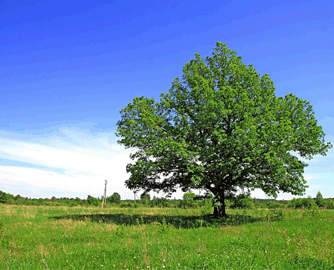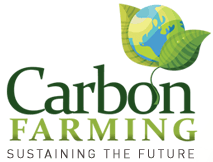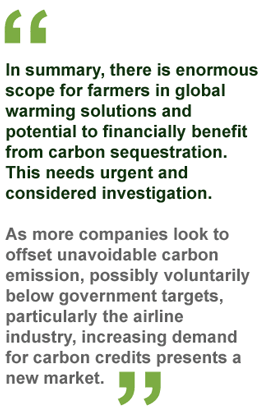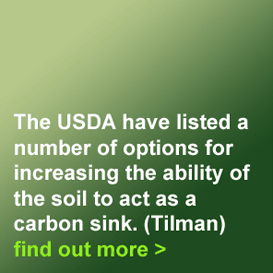| | Opportunities in Solutions to Climate Change
Carbon - Our New Cash Crop The emission of carbon dioxide (CO2), already has a value determined by market forces. Other green house gases (GHGS) will follow. Government regulation will increasingly force business to account for the external environmental costs of their activities.
GHGS are those gases that absorb and re-emit infra-red radiation in the earth’s atmosphere. These gases occur through both natural and human- influenced processes. The major GHG is water vapour. Others include CO2, nitrous oxide (N2O), methane (CH4), ozone (O3) and chloroflourocarbons (CFCS). Nitrous oxide and methane have a global warming potential respectively of 310 and 33 times that of carbon dioxide.
This means that the production of CO2 cannot be taken in isolation. Processes which reduce CO2 emissions might increase emission of others, offsetting any improvement. To put carbon in context, it constitutes 95% of all matter in the universe; is the basis of all fuels; and in the form of carbohydrates is the product of photosynthesis.
The growing threat of climate change and global warming will force business and corporations to review company policy on the impacts of their emissions of CO2 and carbon on the environment and society as a whole. These will be driven by a growing awareness of the public wanting to invest into ethical products. That perception of company and brand values will become paramount in response to this rise in public awareness and fear of the future impact of climate change. Some of the sectors such as airlines have a much greater percentage of their brand value at risk, up to 50% perhaps compared to the commoditized sectors such as oil and gas at 2%, where there is less consumer choice. It is fair to say that climate changes due to increased GHGS emissions will become relevant to most businesses, though not always in ways that are clear or predictable.
To date these issues are being addressed in a number of ways. The “Grassroots” Research Tool was developed to identify and confirm where material effects of environmental and social issues impact on company value. Defra are looking at Key Performance Indicators which will assess more environmental issues and be useful in company communication strategy. The Carbon Disclosure Project has for instance encouraged companies to provide details of their Carbon audits on a voluntary basis. With these and more to come, the exposure of different sectors of industry to climate can be analysed and quantified. This information will allow farmers to target the marketing of their GHG and environmentally- friendly products, more appropriately.
The European GHG emission trading scheme was established in January 2005 in response to the Kyoto protocol. This requires the monitoring and reduction of CO2 from about 12000 installations, including oil and gas refineries, metal processors, glass, cement, pulp and brick manufacturers across 25 member states. The scheme operates on a ‘cap and trade’ basis by which member states set an emissions cap for each installation. Other states have been more generous than the British Government, it now appears. Businesses can sell any carbon allowances or credits that they do not use or buy extra permits in the market. Businesses that emit more than their allowances, either through expansion or failure to invest in more efficient technology, will have to buy extra permits in the market. Closure of many inefficient factories and plants in Eastern Europe has provided for some surplus of credits coming on to the market.
The UK emits millions of tons of CO2 per year. The British Government set a Kyoto target of reducing our GHG emissions base level by 12.5% by 2010 but only 35% of our total emission output is actually covered by this target. The UK was allocated 230 million tonnes for the relevant industries. Aviation, shipping and agriculture are not included yet.
The Kyoto Protocol also established principles of financial and technological transfers to land management projects and initiatives.
If the reduction of GHGS in the atmosphere is an environmental ‘good’ and now has (or will have) an economic value or opportunity cost, how can farmers and agriculture benefit. What is it able to offer? What value does this have and how can it be unlocked?
Carbon sequestration is the capture and secure storage of carbon that would otherwise be emitted or remain in the atmosphere (FAO 2000) Technology, Industry, Agriculture and Geology offer possible carbon sequestration options. Agriculture is an accumulator of carbon in two ways:
1. In the form of organic matter in the soil, considered to be the largest terrestrial carbon pool
2. When above ground biomass acts as a permanent sink or is used as an energy source that substitutes for fossil fuels.
The USDA have listed a number of options for increasing the ability of the soil to act as a carbon sink. (Tilman)
back to top > | |  | |





